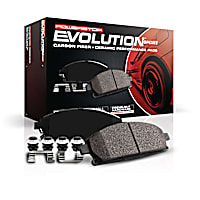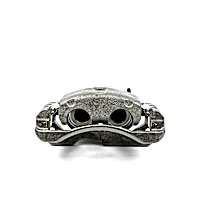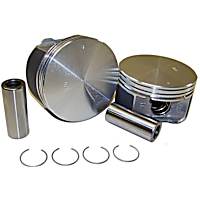Before spending your hard-earned money on a new caliper, you’ll want to make sure the old one is bad. The good news is that caliper diagnosis is straightforward and doesn’t require fancy equipment.
Brake Caliper Inspection Methods
Caliper diagnosis isn’t as difficult as you might think. If you’re ready and willing to get dirty, there are several methods you can use to troubleshoot a bad caliper.
Note: The following are general guidelines for educational and entertainment purposes only. Consult your vehicle’s factory information for specific repair instructions and recommended safety procedures.
1. Inspect for Leaks
Got a low or spongy brake pedal? One of the most common causes is a leaking caliper, so the first step in your diagnosis is to look for leaks. Check the areas around the caliper piston as well as the bleeder screw for signs of fluid loss.

2. Look at the Brake Pads
A stuck brake caliper or sticking caliper sliders can cause uneven brake pad wear. To check for this, safely raise and support your vehicle, remove the caliper and take a look at your brake pads.

Is one pad much thicker than the other? If your car has floating calipers, uneven pad wear usually indicates that the slider bolts or slider pins are sticking. Check that the sliders move freely. If they don’t, clean and lubricate them to restore proper operation.
If you find uneven pad wear, but the sliders are OK (or your car has fixed calipers without sliders), you’ll want to move on to the next step: checking caliper piston operation.

3. Check Piston Operation with a Tool
A stuck piston is another common caliper problem. A piston that’s stuck in the applied position (out of its bore) can cause brake drag, uneven brake pad wear, and a vehicle that pulls to one side.
There are a few ways to check for this condition. Start by safely supporting the vehicle on jack stands and attempting to turn the wheel/tire assembly by hand. If the wheel is hard to turn, you may have a caliper that’s sticking and pushing the pads against the rotor.
You can also check the caliper piston by trying to push it back into its bore. Here’s how it’s done:
- Start by safely raising the vehicle and supporting it with jack stands.
- Remove the wheel and tire assembly.
- Unbolt the brake caliper from the mounting bracket and pull it away from the rotor. Do not unbolt the brake hose.
- Use a large C-clamp or disc brake spreader to push the piston back into its bore. When doing this, keep an eye on the master cylinder to make sure fluid doesn’t get pushed out of the reservoir.

Note: Some calipers require a special wind back tool to push the caliper piston back into its bore. This tool is often required on rear calipers that have an integrated parking brake. Also, in some instances, a scan tool is required to put the brake system in service mode. Consult the factory repair information for your vehicle before performing this test.
- A good caliper piston should be able to push back until it’s completely seated in its bore. A bad caliper piston, on the other hand, will be difficult or impossible to push back.
But wait – if the caliper can’t be pushed back into its bore, how do you rule out a restricted brake hose? Crack the bleeder screw on the caliper and try pushing the piston back into its bore. If the piston still doesn’t move, the caliper (not the hose) is probably to blame. It’s also possible that the bleeder screw is restricted.
Warning: After reinstalling the brake caliper, make sure to pump the brakes until they’re firm. DO NOT drive the car until the brakes feel solid.
Only pump the brakes after everything is reassembled and the car is on the ground. If you pump the brakes with the caliper removed, the caliper piston will come shooting out.

4. Check Piston Operation with a Buddy
A piston that’s stuck in the retracted position (inside its bore) can cause problems such as a low brake pedal. If you have a friend handy, you can check that the piston moves both in and out properly. Simply have your buddy apply the brakes while you monitor caliper operation.
- Start by safely raising the vehicle and supporting it with jack stands.
- Remove the wheel and tire assembly.
- Have your assistant push the brake pedal.
- Watch the caliper piston come out of its bore and push the brake pads against the rotor.
- Have your assistant take their foot off the brake pedal.
- Watch the caliper piston return into its bore.
Not only does this procedure ensure that the caliper piston is moving inward, but it allows you to see if the piston is moving outward as well.
5. Attempt an Advanced Line Lock Test
But wait – there’s more. Although some DIYers shy away from the more advanced line lock test (because the brake hoses can be damaged), it’s sometimes used by professionals.
When there’s a soft brake pedal concern, this method can be useful for isolating a bad caliper. A special brake hose pinch tool (a.k.a. line lock tool) must be used to prevent damage to the brake hoses. A set of regular vise grips should not be used.

The process involves pinching off the brake hoses from the calipers one at a time. If the brake pedal firms up when one of the hoses is pinched off, the corresponding caliper may be faulty. You’ll want to inspect it further for leaks and other issues.
You may also watch this video to get an idea of how to replace the rear brake calipers:
Find Reliable Brake Calipers For Your Car
Brake calipers work with the rest of the brake system to slow down or stop your car. If one of the calipers stops working, leave your vehicle in the garage to avoid damaging other brake parts. Order replacement brake calipers from CarParts.com that fit your car like factory-issue brake parts.
CarParts.com helps you find new brake calipers quickly and easily. Simply plug important info into our website’s built-in vehicle selector, and you’ll find the products in our sizable parts catalog that meet your specific needs. Ordering the part you want is a breeze and can be done on your phone. You also won’t have to wait long for your order to reach your home. If you live in the continental US and send your order before noon ET, you can get your new brake calipers in several business days.
So what are you waiting for? Order replacement brake calipers from CarParts.com, and we’ll deliver them straight to your doorstep. Check out our selection of high-quality brake calipers today.
Products Mentioned in this Guide
Any information provided on this Website is for informational purposes only and is not intended to replace consultation with a professional mechanic. The accuracy and timeliness of the information may change from the time of publication.


 Brake Pad Set
Brake Pad Set
 Brake Caliper
Brake Caliper
 Piston
Piston















